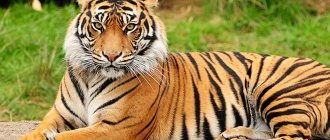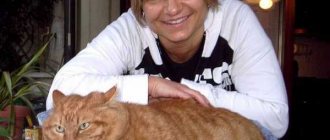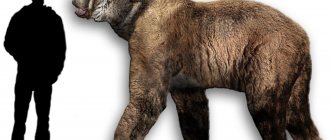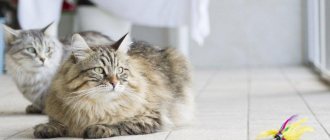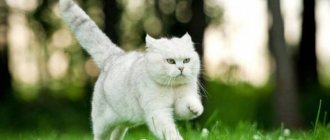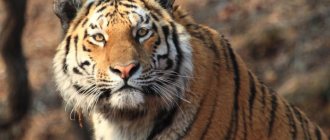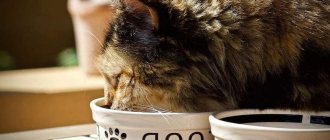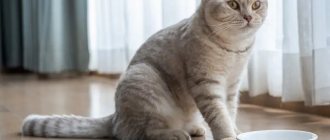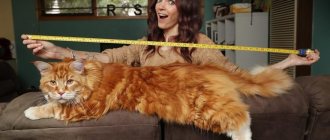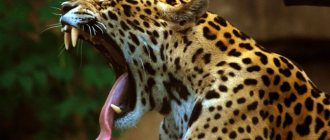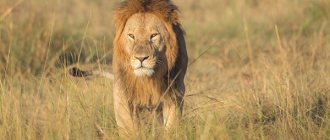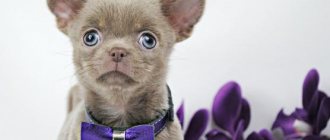Why do some people like big cars, while others are happy with small models? Some feel comfortable in small, cozy apartments, but there are people who do not recognize tiny spaces. Psychologists probably have explanations for everything, including why some owners have not just cute cats, but big cat breeds
.
It’s easy to imagine a miniature pussy in the house, but what if such a purr weighs 7 kg or more? Large domestic cats fit very harmoniously into the home interior, looking regal and graceful. Such animals are much more reminiscent of their wild relatives and force one to reckon with their feline character.
Felinologists have done their best in breeding domestic big cats of different breeds, and we can introduce you to the largest representatives of felines.
Savannah
This animal amazes others with many of its characteristics, namely height, weight, etc. But the main surprise awaits those who decide to buy a kitten of this breed for themselves. The price is truly astronomical, although it is due to the fact that this breed has only 1 thousand individuals, and the first offspring were born only in the spring of 1986.
The basis of this breed was the domestic cat and the wild African serval. As a result, an animal was born, distinguished by its unique color, large ears, long legs, as well as fantastic jumping ability (up to 3 meters) and love for the water element. Savannah not only loves to swim, she is an excellent swimmer and is able to cover enormous distances across the surface of the water.
In addition, the Savannah has a developed intellect, she has an easy-going character and is devoted to her owner.
Features of keeping giant cats
Large pets require special conditions. They need more food and exercise. Otherwise, their health may suffer.
Feeding
Avoid two things: overfeeding and mono-feeding. Animals reach their maximum weight only by 3-4 years, so there is no need to contribute to its gain ahead of time. In this case, instead of a muscular and graceful cat, you will have a bun that moves with difficulty.
When calculating daily caloric intake, be guided by the average recommendations, but be sure to adjust them to suit your pet through observations. The higher the activity, the more food is required. An insufficient amount of food can be easily tracked by weight loss, so do not forget about periodic weighing.
Don't feed your cat only meat. Animal proteins are healthy and nutritious, but such a diet may result in a deficiency of calcium and other important elements. In addition to them, the diet should contain:
- fats (sea fish, flaxseed);
- carbohydrates (zucchini, apples, oatmeal);
- sprouted oats and brewer's yeast.
On a natural basis, it is recommended to add vitamins to food. They are selected by a veterinarian based on tests.
Large animals often suffer from diseases of the musculoskeletal system. If your pet eats dry food, take him food with chondroprotectors that improve the functionality of the joints.
Predisposition to disease
Heavy weight puts a lot of stress on bones and joints, so first of all you should be wary of arthritis and dysplasia. In addition to proper nutrition, prevention includes mandatory observation by a veterinarian. A predisposition to joint pathologies is usually inherited, so be sure to check information about the kitten’s parents before purchasing it.
All other ailments depend not on the size of the cat, but on its breed. Maine Coons are prone to diseases of the urinary system, Siberians - to food allergies, Ragdolls - to cardiovascular diseases, and Chausies - to digestive disorders.
If you decide to purchase a purebred pet, study detailed information about the features of its maintenance and care. This will allow you to adequately assess the risks and compare them with your capabilities.
Do you like the article? 0
Maine Coon
This breed rightfully takes second place in the list of the largest cat breeds. Representatives of this breed have a weight of about 15 kilograms and a rather menacing appearance. At the same time, they find a “common language” with both adults and children, without offending pets either.
These animals have a characteristic color and a powerful tail, like raccoons. Thanks to these features, the name appeared, which translated means “Mensky raccoon”. Maine is the name of the state in the United States where the ancestors of Maine Coons were once kept on farms.
The breed is practically devoid of disadvantages, with the exception of its astronomical cost. Cats are easy to train and always demonstrate nobility, intelligence, calm disposition and grace.
10 ABNORMALLY BIG CATS IN THE WORLD
Well-fed Elvis
The cat's owners are currently trying their best to help him cope with excess weight. Elvis is given insulin injections twice a day and has also been prescribed a special diet to lose weight. They say that with the help of thoughtful nutrition, the gray and white cat got rid of 1 kilogram and continues to lose weight.
Now Elvis is considered “the fattest cat in Germany.” But according to the volunteers who took care of the animal’s health, this cat may receive the title of “the fattest cat in the world.” His weight, even after losing weight, remains greater than that of the cat, which is now recorded as “the fattest in the world” in the Guinness Book of Records.
Chausie
It is considered not only one of the largest, but, at the same time, the rarest breed, the weight of which can reach at least 14 and a half kilograms.
The breed was born in 1990 and is a hybrid of an Abyssinian cat and a jungle cat. The jungle cat prefers to live in swamps, which is why it is also called the swamp lynx.
As a result of hard work, breeders managed to get a cat that has the power of a predator and the docile nature of a domestic cat. Chausie cats are quite strong cats, with an athletically complex body, a large (comparatively) head, large ears, and green or yellow eyes. Despite such external characteristics, the breed is devoted to its owner and feels great around children.
Interesting Facts
The biggest cats also include the fattest. According to the Guinness Book of Records, today this title is awarded to the cat SpongeBob, who weighs 15 kg. The pet is currently on a diet. And in general, the founders of the book decided to remove this category from great achievements, so that cat owners would not try to become famous at the expense of the health of their pets.
Throughout the history of records, the prize has been awarded several times, and according to its statistics, the fattest was an Australian cat named Khimiya, whose weight was more than 21 kg. The poor guy died from obesity and related diseases.
Having the biggest cat in your personal possession is not the greatest achievement. Yes, size matters, but love for your pet should come first.
Let's watch a video from the Nat Geo channel about another of the biggest and fattest cats in the world, named Meow:
Ragamuffin
California is considered the birthplace of this breed, and it was born as a result of the efforts of Ann Baker, who decided to modify the Ragdoll. So she began to crossbreed the Ragdoll with other cat breeds, such as the Persian, the Yard Longhair, and the Himalayan.
As a result of these efforts, a breed was born that was called “cherub,” but at the last moment it was renamed and began to be called “ragamuffin,” which means “ragamuffin.”
Adults weigh at least 10 kilograms and acquire impressive sizes, although they mature only at 4 years of age. The breed does not have a beautiful, proportional physique, but it is distinguished by a variety of coat colors.
Ragdoll
This is a breed obtained through selection in the 20th century. Breeder: Ann Baker from California, USA. The breed was registered in 2000. Known for her flexible character.
View this post on Instagram
A post shared by Victor Ray (@v1cr4v)
The name comes from the habit of relaxing. The pet purring in your arms sags, resembling a rag doll. It is believed that the observed flexibility of the cat is associated with a genetic disorder. Height at withers – 30–40 cm. Weight – 7–12 kg.
Kurilian Bobtail
The list of the largest cat breeds is replenished with another giant, since adult individuals can weigh at least 7 kilograms.
This breed of cats was once moved from the Kuril Islands to the mainland at the end of the last century.
The breed is distinguished by the original shape of its tail, which is quite short (only 8 cm maximum) and somewhat resembles a pom-pom. If a cat of this breed has a tail longer than 8 cm, then this is considered a fault of the individual, and if its length is only 12 cm, then the cat can be removed from the competition.
Kuril bobtails are not afraid of either moisture or frost, although they do not like to swim, but at the same time they are excellent at hunting fish.
The behavior of this breed of cat is somewhat reminiscent of the behavior of dogs, since they are very curious, are highly active and never refuse long walks and fun games, involving various toys, where they carry them in their owner’s teeth, like dogs.
Chartreuse
The ancestors of the Chartreuse are unknown. But felinologists associate the appearance of the breed with the Crusaders and the Order of the Carthusians. Chartreuses accompanied ships to Africa, saving ship supplies from rodents.
View this post on Instagram
A post shared by Victor Ray (@v1cr4v)
The cat has 2 features. First of all, there is a pronounced hunter’s instinct. Therefore, the animal is not recommended to live together with rodents and birds. Another feature is long-term growth. The pet grows up to 5 years. The height of an adult Chartreux is 30 cm, weight is 7–9 kg for a male and 4–5 kg for a female.
Norwegian Forest Cat
Due to the fact that the forest cat has long, fluffy fur, it seems that this animal is quite large. In fact, adults generally weigh no more than 9 kilograms.
There is a legend that this breed of cats was brought to Scandinavia by the Vikings in the holds of their ships. What these cats did on ships was to catch rodents, saving sailors from hunger and the bubonic plague, which was spread by rats.
In northern latitudes, cats became slightly domesticated, beginning to live next to humans. In 1934, the stage of breeding work with the Norwegian Forest Cat began, for which purebred representatives of this breed were sought throughout the world, as well as throughout the country. In 1976, the breed was officially recognized throughout the world.
The Norwegian cat is distinguished by its stable psyche; in addition, it is brave and strong, with the skills of a real hunter. These cats are not afraid to be with dogs that have the same easy-going nature, or near children. The Norwegian Forest Cat is considered to be one of the smartest.
Turkish van
The ancestors of the Turkish Van are aboriginal semi-long-haired cats, who from time immemorial lived in the area adjacent to Lake Van, located in Turkey. This breed was discovered in the modern world by British journalist Laura Lushington, a big cat lover. From her trips to this region of Turkey in the 50s of the last century, she several times brought charming kittens, with which the breeding of the Turkish Van cat breed in Europe began. Today, the Turkish Van is recognized by all leading felinological international organizations.
An adult Turkish Van cat can weigh up to 9 kg. His body is muscular, long, with a wide, powerful chest. These pets love water fun and swim well. They are very active, sociable, overly inquisitive and emotional. They have a well-developed hunting instinct. In childhood and adolescence, these cats can even show some aggressiveness, biting and scratching their owners. However, with age their character becomes softer.
In Turkey, aboriginal Van cats (they are called van kedisi here) are very revered, are one of the symbols of the country and are listed in the Red Book. They are credited with the gift of bringing happiness and good luck; these animals are even allowed to enter the mosque. It is possible to export Turkish Vans from the country only with official permission.
Turkish van
Siberian cat
According to some experts, the Norwegian cat and the Siberian cat have common ancestors. Despite this, the Siberian cat is distinguished by both intelligence and intelligence. Moreover, its weight can reach 12 kilograms.
These cats grew and developed in the conditions of the Far Eastern taiga, so they are absolutely fearless animals that are not afraid of their natural enemies.
The Siberian cat is not only smart, but also beautiful, and also not spoiled by selective artificial selection. She is an excellent example of a real hunter, as she is able to hunt even hares.
The Siberian cat has a calm and balanced disposition, which helps her find a “common language” with both adults and children. At the same time, she will easily show who is “the boss”, regardless of who is in front of her, a cat or a dog.
Fourth place – Leopard (Panthera pardus)
Leopard
The fourth largest among wild cats is the leopard. There are 9 subspecies of leopard (African, Indian, Javan, Arabian, Anatolian, Amur, Indochinese, Sri Lankan), which are found in Africa, East and South Asia. These cats live in tropical forests, deserts, savannas, grasslands, mountains, coastal areas, scrub and swampy areas.
Interesting: Animals of Africa
